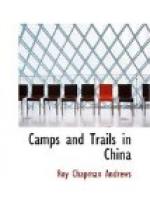The boys turned the beautiful spot into “home” in half an hour and, after setting a line of traps, we wandered slowly back through the darkness guided by the brilliant flames of the fires which threw a warm yellow glow over our little table spread for dinner.
We sent men to the village to bring in hunters and after dinner four or five picturesque Mosos appeared. They said that there were many serow, goral, muntjac and some wapiti in the forests above the village, and we could well believe it, for there was never a more “likely looking” spot. Although the men did not claim to be professional hunters, nevertheless they said that they had good dogs and had killed many muntjac and other animals.
They agreed to come at daylight and arrived about two hours late, which was doing fairly well for natives. It was a brilliant day just warm enough for comfort in the sun and we left camp with high hopes. However it did not take many hours to demonstrate that the men knew almost nothing about hunting and that their dogs were useless. Because of the dense cover “still hunting” was out of the question and, after a hard climb, we returned to camp to spend the remainder of the afternoon developing photographs and preparing small mammals.
Our traps had yielded three new shrews and a silver mole as well as a number of mice, rats, and meadow voles of species identical with those taken on the Snow Mountain. It was evident, therefore, that the Yangtze River does not act as an effective barrier to the distribution of even the smallest forms and that the region in which we were now working would not produce a different fauna. This was an important discovery from the standpoint of our distribution records but was also somewhat disappointing.
The photographic work already had yielded excellent results. The Paget color plates were especially beautiful and the fact that everything was developed in the field gave us an opportunity to check the quality of each negative.
For this work the portable dark room was invaluable. It could be quickly erected and suspended from a tree branch or the rafters of a temple and offered an absolutely safe place in which to develop or load plates. The moving-picture film required special treatment because of its size and we usually fastened in the servants’ tent the red lining which had been made for this purpose in New York. Even then the space was so cramped that we were dead tired at the end of a few hours’ work.
One who sits comfortably in a theater or hall and sees moving-picture film which has been obtained in such remote parts of the world does not realize the difficulties in its preparation. The water for developing almost invariably was dirty and in order to insure even a moderately clear film it always had to be strained. For washing the negative pailful after pailful had to be carried sometimes from a very long distance, and the film exposed for hours to the




